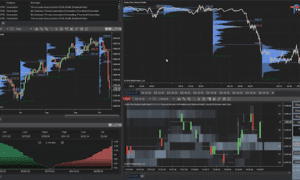The cryptocurrency trading landscape has undergone a remarkable transformation since Bitcoin’s early days. What started as simple peer-to-peer exchanges has evolved into a sophisticated ecosystem of trading platforms, each promising to deliver the ultimate trading experience. Yet many traders still struggle with outdated systems that fail to meet their needs.
Modern crypto traders demand more than basic buy-and-sell functionality. They need platforms that combine cutting-edge technology with user-friendly design, advanced security measures, and comprehensive analytical tools. The next generation of crypto trading platforms is emerging to address these demands, offering solutions that go far beyond traditional exchanges.
Current Landscape: Where Traditional Platforms Fall Short
Today’s crypto trading environment is dominated by established exchanges that, while functional, carry significant limitations that impact trader success and satisfaction.
The Problem with High Fees
Traditional crypto trading platforms often burden users with excessive transaction fees and hidden costs. These charges can quickly erode profits, particularly for active traders who execute multiple transactions daily. Many platforms layer on additional fees for deposits, withdrawals, and even basic trading features, creating an expensive barrier to entry for newcomers.
Limited Analytical Capabilities
Most existing platforms provide basic charts and minimal analytical tools. Traders seeking advanced technical analysis often must rely on third-party applications, creating a fragmented experience that slows decision-making. This limitation becomes particularly problematic during volatile market conditions when quick analysis can mean the difference between profit and loss.
Security Vulnerabilities
Despite years of development, many crypto trading platforms remain vulnerable to security breaches. The centralised nature of most exchanges creates single points of failure, making them attractive targets for hackers. Recent high-profile breaches have highlighted these ongoing security concerns, eroding trader confidence.
User Experience Challenges
Complex interfaces and unintuitive navigation plague many trading platforms. New traders often find themselves overwhelmed by cluttered dashboards and confusing terminology. Even experienced traders frequently struggle with platforms that prioritise features over usability, leading to costly mistakes and missed opportunities.
Regulatory Compliance Issues
Many platforms operate in regulatory grey areas, offering little transparency about their compliance status. This uncertainty creates risks for traders who may find their funds frozen or their access restricted without warning. The lack of clear regulatory frameworks compounds these challenges.
Key Features of Next-Generation Trading Platforms
The next wave of crypto trading platforms addresses these limitations through innovative features designed around trader needs and market realities.
Advanced Security Architecture
Next-generation platforms implement multi-layered security systems that go beyond traditional approaches. These include:
Decentralised Infrastructure: By distributing operations across multiple nodes, these platforms eliminate single points of failure. Smart contracts automate many functions, reducing human error and potential manipulation.
Multi-Factor Authentication: Advanced biometric verification systems, hardware security keys, and behavioural analysis create robust protection against unauthorised access.
Cold Storage Integration: Automatic transfer of funds to offline storage when not actively trading provides an additional security layer that protects against online threats.
Intelligent Trading Tools
Modern platforms integrate artificial intelligence and machine learning to enhance trading capabilities:
AI-Driven Market Analysis: Sophisticated algorithms analyse market patterns, news sentiment, and trading volume to provide actionable insights. These systems can identify potential opportunities and risks faster than human analysis alone.
Automated Trading Strategies: Smart trading bots execute pre-defined strategies based on market conditions. These tools allow traders to capitalise on opportunities even when they cannot actively monitor the markets.
Risk Management Systems: Advanced algorithms automatically adjust position sizes and implement stop-losses based on individual risk tolerance and market volatility.
Enhanced User Experience
Next-generation platforms prioritise intuitive design and seamless functionality:
Customisable Dashboards: Traders can personalise their interface to display relevant information and tools. This customisation reduces cognitive load and improves decision-making speed.
Mobile-First Design: Responsive platforms that work seamlessly across devices ensure traders never miss opportunities due to technical limitations.
Educational Integration: Built-in learning resources and tutorials help new traders develop skills while providing advanced users with market insights and analysis techniques.
Transparent Fee Structures
Modern platforms implement clear, competitive pricing models:
Zero Hidden Fees: All costs are displayed upfront, allowing traders to calculate exact transaction costs before executing trades.
Dynamic Pricing: Fee structures that adjust based on market conditions and trading volume provide fair pricing for all users.
Reward Systems: Loyalty programmes and reduced fees for active traders create incentives for platform engagement.
Regulatory Compliance
Next-generation platforms proactively address regulatory requirements:
KYC/AML Integration: Streamlined identity verification processes that comply with international standards while maintaining user privacy.
Regulatory Reporting: Automatic generation of tax documents and trading reports simplifies compliance for traders in different jurisdictions.
Licencing Transparency: Clear information about regulatory status and operational licences builds trust and reduces legal risks.
Practical Applications: How Next-Gen Platforms Transform Trading
The real value of next-generation crypto trading platforms becomes apparent through their practical applications in various trading scenarios.
Professional Day Trading
Professional traders require split-second execution and comprehensive analysis tools. Next-generation platforms provide:
Low-Latency Execution: Advanced infrastructure ensures trades execute within milliseconds, crucial for capitalising on short-term price movements.
Advanced Charting: Professional-grade technical analysis tools with multiple timeframes, indicators, and drawing tools support sophisticated trading strategies.
Portfolio Management: Integrated tools for tracking performance across multiple assets and strategies help professional traders optimise their approach.
Institutional Trading
Large-scale institutional traders need platforms that can handle significant volumes while maintaining security and compliance:
High-Volume Capabilities: Platforms designed to handle large transactions without impacting market prices or system performance.
Custody Solutions: Integration with institutional custody services ensures secure storage of large cryptocurrency holdings.
Compliance Reporting: Automated reporting systems that meet institutional audit and regulatory requirements.
Retail Investor Access
Next-generation platforms make sophisticated trading tools accessible to everyday investors:
Simplified Interfaces: Clean, intuitive designs that don’t overwhelm new users while providing access to advanced features when needed.
Educational Resources: Interactive tutorials and market analysis help retail investors develop trading skills and market understanding.
Fractional Trading: The ability to purchase fractions of expensive cryptocurrencies makes investing accessible to users with limited capital.
Cross-Border Trading
Global traders benefit from platforms designed for international use:
Multi-Currency Support: Native support for various fiat currencies reduces conversion costs and complexity.
Regulatory Compliance: Operations that comply with regulations in multiple jurisdictions provide legal certainty for international traders.
Localised Features: Region-specific payment methods and customer support ensure smooth operations regardless of location.
The Rise of Decentralised Trading
Decentralised exchanges (DEXs) represent perhaps the most significant evolution in crypto trading platforms. These systems operate without central authorities, using smart contracts to facilitate trades directly between users.
Benefits of Decentralised Trading
Enhanced Privacy: Users maintain control of their private keys and personal information, eliminating concerns about data breaches or misuse.
Censorship Resistance: Decentralised platforms cannot be shut down by single entities, providing reliable access to trading services.
Global Accessibility: Anyone with an internet connection can access decentralised trading platforms, regardless of geographical restrictions.
Challenges and Solutions
While decentralised trading offers significant advantages, it also presents unique challenges:
Liquidity Concerns: DEXs often struggle with lower trading volumes compared to centralised exchanges. Next-generation platforms address this through liquidity aggregation and cross-chain compatibility.
Technical Complexity: The technical knowledge required to use DEXs can be daunting for new users. Modern platforms solve this through improved user interfaces and educational resources.
Transaction Speeds: Blockchain congestion can slow transaction processing. Layer-2 solutions and alternative consensus mechanisms improve performance significantly.
Integration with Traditional Finance
Next-generation crypto trading platforms increasingly bridge the gap between traditional finance and cryptocurrency markets.
Banking Integration
Direct Bank Connections: Seamless integration with traditional banking systems allows instant deposits and withdrawals without third-party payment processors.
Fiat On-Ramps: Multiple options for converting traditional currencies to cryptocurrencies and vice versa provide flexibility for users.
Credit and Lending: Integration with DeFi lending protocols allows traders to access credit using their cryptocurrency holdings as collateral.
Investment Products
Crypto Derivatives: Access to futures, options, and other derivative products allows sophisticated risk management and speculation strategies.
Index Funds: Cryptocurrency index products provide diversified exposure to the crypto market without requiring individual asset selection.
Staking Services: Built-in staking capabilities allow users to earn passive income from their cryptocurrency holdings.
Future Outlook: The Evolution Continues
The development of next-generation crypto trading platforms represents just the beginning of a broader transformation in financial services.
Emerging Technologies
Quantum Computing: Future platforms may leverage quantum computing for enhanced security and computational capabilities.
Virtual Reality: VR interfaces could provide immersive trading experiences with three-dimensional data visualisation.
Internet of Things: IoT integration might enable automated trading based on real-world events and data streams.
Market Maturation
As the cryptocurrency market matures, trading platforms will likely become more specialised, catering to specific user segments and trading strategies. This specialisation will drive innovation and competition, ultimately benefiting traders through improved services and lower costs.
Regulatory Development
Clearer regulatory frameworks will enable platforms to operate with greater certainty while providing users with enhanced protection. This regulatory clarity will likely accelerate institutional adoption and mainstream acceptance of cryptocurrency trading.
Transforming the Trading Experience
The next generation of crypto trading platforms represents a fundamental shift from the limitations of traditional exchanges to comprehensive, user-centric solutions. These platforms address longstanding issues around security, usability, and functionality while introducing innovative features that enhance the trading experience.
For traders seeking to capitalise on cryptocurrency market opportunities, selecting the right platform has become increasingly important. The combination of advanced security, intelligent trading tools, and seamless user experience offered by next-generation platforms provides significant advantages over traditional alternatives.
The evolution of crypto trading platforms continues to accelerate, driven by technological advancement and user demand for better solutions. As these platforms mature and adopt new technologies, they will likely become even more sophisticated, accessible, and integral to the broader financial ecosystem.
Understanding the landscape of crypto trading platforms helps traders make informed decisions about their tools and strategies. For comprehensive insights into specific platforms and their features, resources like Crypto30x.com Ocean provide valuable analysis and comparisons.
The future of crypto trading lies in platforms that combine the best of traditional finance with blockchain innovation, creating seamless, secure, and powerful tools for traders at every level.
For in-depth analysis and the latest developments in crypto trading platforms, visit the BizSenso platform for comprehensive industry insights.



































